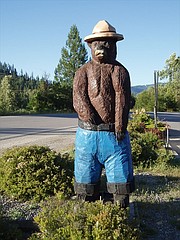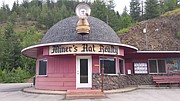Our roadside vernacular: Part 2
Crystal Gold Mine & RV Park
For more than two decades, the miner has waved from his 40 foot perch over an entrance to the Crystal Gold Mine and RV Park in Kellogg.
The lifelike figure is mounted besides an ore car in front of a painted mine backdrop.
The scene is not some faux mine-country Disney-Rama, but instead an aerial diorama that invites the tourist to learn about what was among the first hard rock mines in the Silver Valley.
The miner may wear tattered clothes, but he definitely knows his business.
“We are doing our best to preserve the history,” said Ray Cropp and wife Sherry who own the attraction that features gold mine tours and other educational/recreational activities.
The Crystal Gold Mine was worked sometime in the 1880s.
It was then closed by hiding the mine.
During the 1960s, the mine entrance was exposed during building of Interstate 90.
Then in 1991, the owner dug deeper into the entrance and rediscovered more of the mine.
In 1996, Bill and Judy Lane purchased it and opened it as a tourist attraction for several years.
After their deaths, the mine was purchased by the present owners who reopened in 2012.
Judy Lane made the miner as well as painting some of the other scenes on site.
He appears to be glazed papier mache cobbled with heavy gauge steel on a wood stand.
A backdrop of a mine entrance completes the scene.
Unlike many other flat signs, the miner is classic roadside vernacular utilizing three-dimensional folk art elements.
“He’s sun bleached,” said Ray about the miner.
“He’s got a lot of character.”
“People use it as a focal point for the mine tour. People use it as a visual aid. It’s a historic icon.”
The Miner’s Hat and Mary Etta Page
The Miner’s Hat Realty is arguably the Silver Valley’s most recognizable example of roadside vernacular.
It is also a rare example of what architect Robert Venturi’s defines as a “duck” as “opposed to a “decorated shed.”
In Venturi’s world if it looks like a duck and quacks like a duck, then it is not a decorated shed.
“The duck,” wrote Venturi, “the building is the sign.”
In fact, the Miner’s Hat ranks among the disappearing crown jewels of roadside architecture, surviving various incarnations from roadside diner to drive in to real estate office.
To see this huge miner’s hat with carbide lamp is to engender nostalgia worship from locals for its renown “Coney Island” hot dogs.
To see the whimsical structure from the interstate is to cause Venturi acolytes to slam on the brakes and do double takes.
In the book, The Well-Built Elephant and Other Roadside Attractions, it is cited as the “World’s Largest Miner’s Hat.”
In this vanishing landscape of novelty architecture and signage, threatened by age, neglect, apathy or development, the Miner’s Hat like the Big Duck in Long Island, Paul Bunyan and Babe, the Blue Ox, in Minnesota, or Randy’s Donuts in California have value as architectural artifact and cultural icon entrenched in Silver Valley life and history.
“My grandmother owned and ran the Miner’s Hat,’’ said Randy Noland.
His grandmother, Mary Etta Page, founded and operated the diner next to Highway 10 in Kellogg.
It was built around 1939.
Besides, the Miner’s Hat, Mary Etta also owned the Boat Restaurant in Smelterville.
Her daughter, Emma, owned and operated the Boat Restaurant in the Boat in Coeur d’Alene.
Using the Miner’s Hat programmatic architecture approach, the restaurants were made to look like old time river boats.
“She was known as the best cook around. She was known for her Coney Island hot dogs. She made everything herself,” said Randy, regarding her homemade potato salads, roasts, pies, pasties, soups.
“She was a feisty woman. She lived to be a 101. Her Coney recipe was under lock and key.”
Over the years, the The Miner’s Hat developed into a classic drive-in complete with requisite milk shakes, burgers and car hops.
In 1963, Mary Etta closed the diner concerned about lack of customers due to the construction of Interstate 90 besides Highway 10.
In 1967, Ted Reynolds bought it and made it a real estate office where Shelly Hopper worked as an associate.
In 1991, Hopper purchased it as much for business as a labor of love in remembrance of her mother, Cloris Maxson.
“My mom worked there in the 1940s. She was a car hop. It was her first job,” said Hopper who owns it with her husband, John.
“She was very happy when I bought it.”
“It was a different era.”
Flying Saucer
Near the corner of 5th and Pine in the Center of the Universe is roadside vernacular run cosmic.
Wild, whimsical, and Wallace, this is out of this world signage.
Flanked by the Googie architecture, neon Stardust Motel sign, and a traffic light touting ‘Huckleberry ice cream,’ is a flying saucer.
Guess some alien welder had “too much time on his hands.”
Anyway, this tableau serves up delightful visual elements that advertise the local businesses and bespeak of Wallace as Center of the Universe.
As the old saying goes, “one picture is worth a 1,000 light years.”
“I bought the flying saucer for my wife,” said Jamie Baker who purchased it for his wife, Barbara, as a birthday present about nine years ago.
The pair operate the Red Light Garage restaurant.
“When she saw it, she wanted to buy it. I said, ‘Shouldn’t we think about it?’ She said, ‘I’m 60-years-old. When else will I have a chance to buy a flying saucer?’”
The Kingston Bear
For years, the wooden bear sculpture has been unofficial greeter for visitors to Kingston, placed just off the interstate on the Coeur d’Alene River Road.
The bear has a history steeped in Kingston lore.
Here is some information from locals at the Kings Inn:
The bear was created by chainsaw artist Jerry Beebe Sr.
It was placed there sometime in the 1980s.
As the story goes, a sheriff’s deputy whipped around the corner one time and accidentally ran into the bear, damaging a paw.
Triage was performed by Jerry Beebe Jr. also a chain saw artist.
He fixed the paw.
And the rest is history, urban legend, or a little of both.







